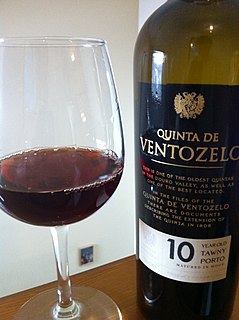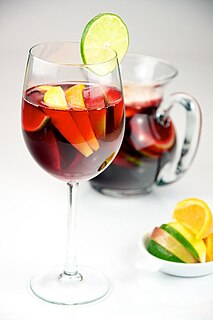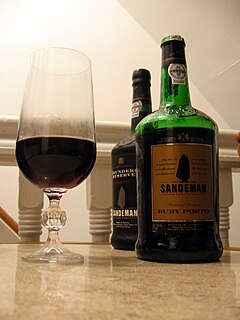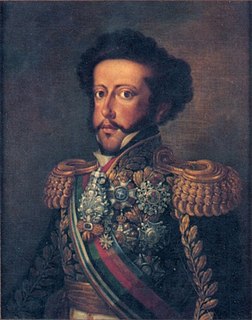External links
- José Maria da Fonseca homepage (in Portuguese) (in English)
Lancers is a brand of medium-sweet, lightly sparkling wine produced by the JM da Fonseca winery in Portugal. The brand was created in 1944, when Vintage Wines of New York predicted that wine consumption in the United States would increase after World War II.
A sparkling Lancers, made by the continuous method, was introduced in the late 1980s. It was originally sold in distinctive squat bottles made of rust-colored, opaque crockery rather than clear glass.

Fortified wine is a wine to which a distilled spirit, usually brandy, has been added. In the course of some centuries, winemakers have developed many different styles of fortified wine, including port, sherry, madeira, Marsala, Commandaria wine, and the aromatised wine vermouth.

Champagne is a sparkling wine originated and produced in the Champagne wine region of France under the rules of the appellation, that demand specific vineyard practices, sourcing of grapes exclusively from designated places within it, specific grape-pressing methods and secondary fermentation of the wine in the bottle to cause carbonation.

Sparkling wine is a wine with significant levels of carbon dioxide in it, making it fizzy. While the phrase commonly refers to champagne, European Union countries legally reserve that term for products exclusively produced in the Champagne region of France. Sparkling wine is usually either white or rosé, but there are examples of red sparkling wines such as the Italian Brachetto, Bonarda and Lambrusco, and the Australian sparkling Shiraz. The sweetness of sparkling wine can range from very dry brut styles to sweeter doux varieties.

Port wine is a Portuguese fortified wine produced in the Douro Valley of northern Portugal. It is typically a sweet red wine, often served with dessert, although it also comes in dry, semi-dry, and white varieties.

Sangria is an alcoholic beverage originating in Spain and Portugal. Under EU regulations only those two Iberian nations can label their product as Sangria; similar products from different regions are differentiated in name.

Vinho Verde refers to Portuguese wine that originated in the historic Minho province in the far north of the country. The modern-day 'Vinho Verde' region, originally designated in 1908, includes the old Minho province plus adjacent areas to the south. In 1976, the old province was dissolved.

Peso da Régua, commonly known as Régua, is a municipality in northern Portugal, in the district of Vila Real. The population in 2011 was 17,131, in an area of 94.86 km2 (36.63 sq mi) km².

A rosé is a type of wine that incorporates some of the color from the grape skins, but not enough to qualify it as a red wine. It may be the oldest known type of wine, as it is the most straightforward to make with the skin contact method. The pink color can range from a pale "onionskin" orange to a vivid near-purple, depending on the grape varieties used and winemaking techniques. Usually, the wine is labelled rosé in French, Portuguese, and English-speaking countries, rosado in Spanish, or rosato in Italian.

Portuguese wine is the result of traditions introduced to the region by ancient civilizations, such as the Phoenicians, Carthaginians, Greeks, and mostly the Romans. Portugal started to export its wines to Rome during the Roman Empire. Modern exports developed with trade to England after the Methuen Treaty in 1703. From this commerce a wide variety of wines started to be grown in Portugal. And, in 1758, one of the first wine-producing regions of the world, the Região Demarcada do Douro was created under the orientation of Marquis of Pombal, in the Douro Valley. Portugal has two wine-producing regions protected by UNESCO as World Heritage: the Douro Valley Wine Region and Pico Island Wine Region. Portugal has a big variety of local kinds, producing a very wide variety of different wines with distinctive personality.
Fonseca may refer to :
A lancer is a cavalry soldier who fights with a lance.
The glossary of wine terms lists the definitions of many general terms used within the wine industry. For terms specific to viticulture, winemaking, grape varieties, and wine tasting, see the topic specific list in the "See also" section below.

Mateus is a brand of medium-sweet frizzante rosé wine produced in Portugal.
The classification of wine is based on various criteria including place of origin or appellation, vinification method and style, sweetness and vintage, and the grape variety or varieties used. Practices vary in different countries and regions of origin, and many practices have varied over time. Some classifications enjoy official protection by being part of the wine law in their country of origin, while others have been created by, for example, growers' organizations without such protection.

California wine production has a rich viticulture history since 1680 when Spanish Jesuit missionaries planted Vitis vinifera vines native to the Mediterranean region in their established missions to produce wine for religious services. In the 1770s, Spanish missionaries continued the practice under the direction of the Father Junípero Serra who planted California's first vineyard at Mission San Juan Capistrano.
Moscatel de Setúbal is a Portuguese muscatel produced around the Setúbal Municipality on the Península de Setúbal. The region is known primarily for its fortified Muscat wines known as Moscatel de Setúbal. The style was believed to have been invented by José Maria da Fonseca, the founder of José Maria da Fonseca, the oldest table wine company in Portugal dating back to 1834. J.M. Fonseca company still holds a quasi-monopoly control over the production of Moscatel de Setúbal today.

The history of Portuguese wine has been influenced by Portugal's relative isolationism in the world's wine market, with the one notable exception of its relationship with the British. Wine has been made in Portugal since at least 2000 BC when the Tartessians planted vines in the Sado and Tagus valleys. By the 10th century BC, the Phoenicians had arrived and introduced new grape varieties and winemaking techniques to the area. Up until this point, viticulture was mostly centered on the southern coastal areas of Portugal. In later centuries, the Ancient Greeks, Celts and Romans would do much to spread viticulture and winemaking further north.

Fonseca Guimaraens, often simply called Fonseca, is one of the largest Port wine houses in Portugal. Manoel Pedro Gonçalves Guimaraens and his brother João Gonçalves Salgueiro, established the company in 1822 when they acquired control of the Fonseca and Monteiro Company from the Fonseca Family by purchase of the majority of Fonseca owned shares. A condition of the sale of Fonseca's shares was that the name Fonseca remain as the brand name. David Guimaraens, the great-great-great grandson of the founder Manuel Pedro, has been the head winemaker since 1994, and oversees the winemaking and blending for all four Taylor Fladgate Port houses: Taylor Fladgate, Fonseca Guimaraens, Croft, and Delaforce.

José Maria da Fonseca, also known as JM da Fonseca, is the oldest table wine company in Portugal, though some Port wine houses pre-date it. The family-owned company was founded in 1834 and is based in the village of Azeitão on the Setúbal Peninsula. It is now in its 7th generation and most of its production is exported internationally. Among its best known wine brands are Periquita and Lancers.

Irene Maria Quintanilha Coelho da Fonseca is a Portuguese-American applied mathematician, the Kavčić-Moura University Professor of Mathematics at Carnegie Mellon University, where she directs the Center for Nonlinear Analysis.